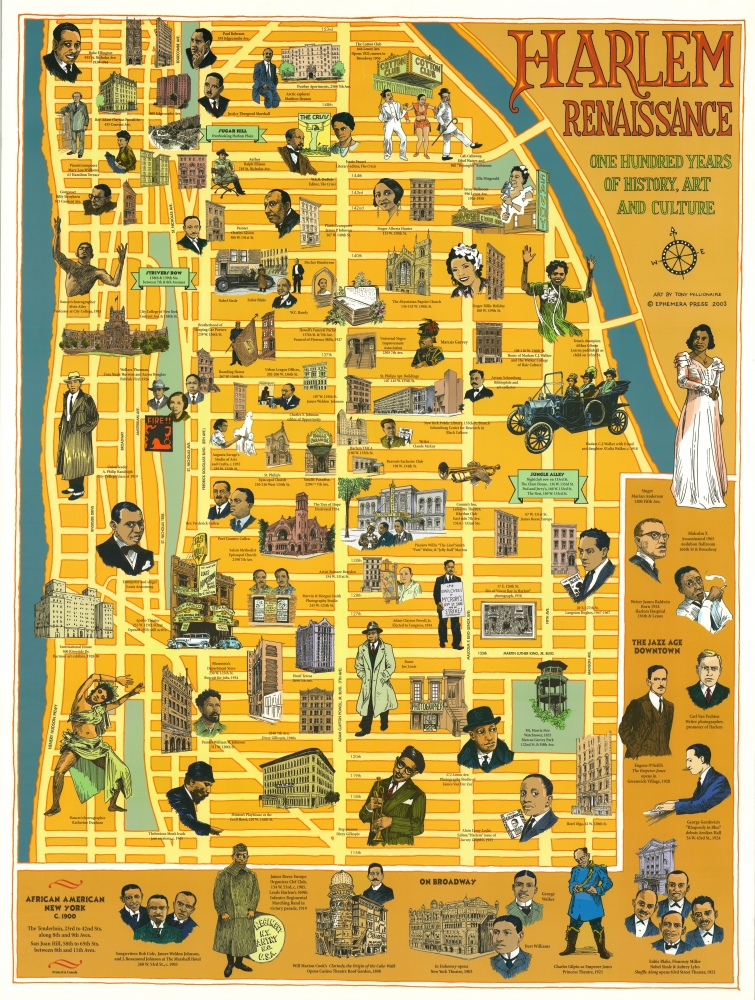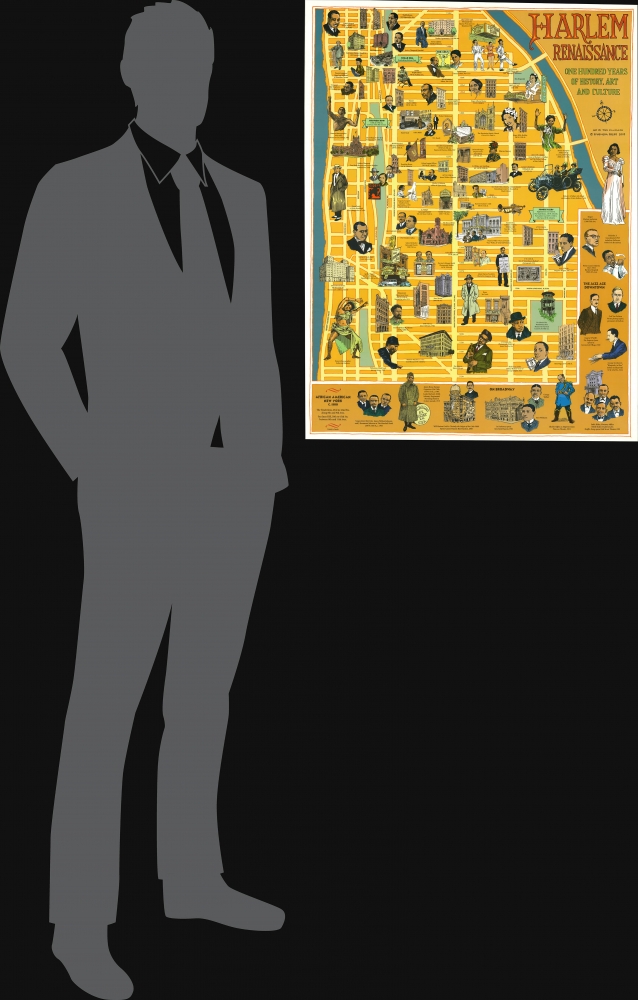2003 Millionaire Pictorial Map of Harlem, New York City, Harlem Renaissance
HarlemRenaissance-millionaire-2003
Title
2003 (undated) 31.75 x 24 in (80.645 x 60.96 cm) 1 : 2700
Description
A Closer Look
The figures drawn on the map are a veritable who's-who of 20th-century African-American culture, from political leaders like Marcus Garvey and Adam Clayton Powell, to civil rights activists (Zora Neale Hurston), judges (Thurgood Marshall), religious leaders (Frederick Cullen), scientists and explorers (Matthew Henson), musicians and composers (Duke Ellington, Marian Anderson, Billie Holiday, Ella Fitzgerald), writers and poets (Countee Cullen, Claude McKay), artists of various stripes (Alvin Ailey, William H. Johnson, Augusta Savage), athletes (Joe Louis, Althea Gibson), and individuals like W.E.B. DuBois and Paul Robeson who transcended several of these categories. A banner at bottom and bottom-right discusses African-American life elsewhere in Manhattan, other Jazz Age writers and composers who were influenced by the Harlem Renaissance (including George Gershwin), and important figures (James Baldwin, Malcolm X) born too late to properly be part of the Harlem Renaissance but who were heavily influenced by it.Famous buildings, organizations, and institutions are also labeled, including churches, hotels, parks, brownstone apartment buildings that were home to the individuals depicted, and famous venues for theater and music, including the Apollo Theater, Cotton Club, and Savoy Ballroom. Other clubs appear, perhaps less famous to history but no less significant. In particular, a group of clubs between 131st and 134th St. are noted, including Smalls Paradise and Barron's Exclusive Club (also known as Barron Wilkin's Club), which were notable for being Black-owned and having an integrated clinetele (unlike the Cotton Club, which catered to a White clientele). Minton's Playhouse on 118th St. is something of a Mecca for jazz music, where jam sessions including the likes of Thelonious Monk and Charlie Parker pioneered the bebop genre.
Some contemporary buildings (the Schomburg Center for Research in Black Culture with its modern extension) and placenames (Adam Clayton Powell Blvd., Malcolm X Blvd., Marcus Garvey Park) appear, but the street grid and most of the buildings in Harlem from the era of the Harlem Renaissance remain today, allowing a user of this map to retrace the steps of those illustrated on it.
The Harlem Renaissance
The Harlem Renaissance, known at the time as the 'New Negro Movement,' was a cultural, social, and artistic movement that took place primarily during the 1920s and early 1930s, centered in the Harlem neighborhood of New York City. It marked a period of prolific creativity among African American artists, writers, musicians, and intellectuals, who used their work to express pride in Black identity and culture, challenge racial stereotypes, and advocate for civil rights. Many leading figures of the Harlem Renaissance had been born in the Deep South and moved to New York City as part of the Great Migration to seek opportunities and escape racism. Other contemporary developments, especially Prohibition and the Great Depression, also had an important impact on the course of the Harlem Renaissance, as did the unique cosmopolitan environment of New York City, drawing in artists, writers, and activists from throughout the African Diaspora. In sum, the Harlem Renaissance marked a cultural flowering and coalescing of social-political consciousness that reverberated for decades afterward, even down to the present.Publication History and Census
This map was drawn by illustrator Tony Millionaire and published in 2003 by Ephemera Press. The original 2001 edition of the map was designed by Kevin Hein, an Art Director at Ephemera Press, with the text done by Marc H. Miller, the founder of the press. The primary differences between the present map and the 2001 edition are the printing, verso content, and size, with the present edition being larger and brighter and lacking the verso content of the earlier edition. The present edition also seems to be significantly rarer than the 2001 edition, not appearing in the OCLC.Cartographer
Tony Millionaire (1956 - present), born Scott Richardson, is an American cartoonist and illustrator, best known for his comics Sock Monkey and Maakies, with its suicidal protagonists Drinky Crow and Gabby, later adapted as a show on Cartoon Network's Adult Swim titled 'The Drinky Crow Show.' Tending towards the graphic, surreal, and ribald, Millionaire's work is influenced by some of the more creative cartoons and comics of the interwar period, though often with a distinctly nautical theme. Born in Gloucester, Massachusetts, to a family of artists, he attended the Massachusetts College of Art in Boston. Moving frequently and struggling as an illustrator in the late 1970s through early 1990s, Millionaire finally broke through with Maakies, first run by the New York Press in 1994. His work has appeared in a variety of formats, including nationwide newspapers, alternative newspapers, television, comic books, record covers, and more. More by this mapmaker...




